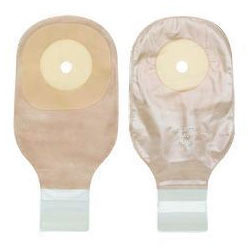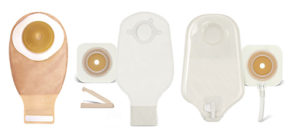Categories
What is an ostomy bag?

An ostomy is a surgical procedure that helps to create an alternative route for the bowels or urinal waste when the normal functionality of organs taking care of the body waste is lost due to a birth defect, disease, injury or treatment for diseases. Conditions that usually require ostomy include injury to bladder or bowel, inflammatory bowel disease, colorectal cancer, diverticulitis, and removal of the bladder. An ostomy could be permanent or temporary depending on why it was carried out in the first place. There are different types of ostomy procedures, including colostomy, urostomy, and ileostomy. For this post, we are going to look into types of ostomies and the ostomy bag that is used after the surgery.
Contents
Types of Colostomy
A colostomy procedure includes creating an opening in the abdomen and bypassing the damaged section or part of the colon and. This artificial opening is called a stoma. The waste is collected in an ostomy bag which is a prosthetic medical device that ensures collection of waste from the stoma. How frequently and consistently the waste will be discharged from the stoma depends on the colostomy procedure that was used. There are four different colostomy procedures that are used being used to date; they are:
- Ascending colostomy
The ascending colostomy is performed on the right side of the abdomen where the colon is ascending. The stool passing through an ascending colostomy is semi-liquid to liquid and thus rich in digestive enzymes which can cause irritation to the patient’s skin around the stoma.
- Descending colostomy
This type of colostomy is carried on the left side of the abdomen where the colon is descending. The stool passing through a descending colostomy is semi-formed to formed as most of the water is absorbed during the transverse and ascending section of the colon.
- Transverse Colostomy
A Transverse Colostomy is performed in the middle of the abdomen where the colon is transverse. Discharge resulting from a transverse colostomy is semi-liquid to liquid but is less irritating than that discharged with the ascending colostomy.
- Sigmoid Colostomy
Sigmoid Colostomy is performed in the sigmoid colon (on the lower-left side of the colon). The stools are fully formed and have normal consistency.
What are the different types of Ostomy bags?
There are different types of ostomy bags that are available nowadays. A patient could either get a one-piece or two-piece ostomy bag with flexible or mechanical coupling. A two-piece ostomy bag which is more commonly used consists of the following:
Base plates
The base plate, aka wafers and flange, are made using organic material like pectin and are available in different sizes to fit well with the stoma and patient’s particular anatomy. If the internal opening is not a fit that could correctly accommodate the size of the stoma, then it could cause the waste to get in contact with skin. The sizing of the baseplate depends on the base plate but some customers prefer to have a customized plate too. In fact, there are manufacturers who offer moldable plates that can be shaped with hands. A two-piece ostomy bag needs an adhesive to stick to the skin. The adhesive is created carefully taking different factors into account like absorption, flexibility, tack, erosion resistance and ease of removal. A barrier film spray is applied every time a new flange is applied as it improves adhesion, provides a soothing effect on the skin and reduces the irritation. The base plate can be used from one to many days depending on the type of ostomy and patient’s lifestyle and anatomy.
Pouches
With a two-piece ostomy bag, the pouch can be replaced without the need to remove the base plate, which is the case with one-piece or press-on ostomy bag. The size of the pouch can vary depending on a person’s individual preferences. For instance, a mini-pouch is used by people for intimate or short-term activities while larger-sized bags are used while sleeping.
Types of Ostomy Bags

There are different types of colostomy bags that are available these days, let’s take a look at them:
- Close-ended bags
Colostomy bags are sealed or closed at the bottom. A close-ended bag is used only once and is used by patients who irrigate, i.e. flush out the stools at scheduled timings.
- Open-ended bags
These bags aren’t discarded after one use. Open-ended bags, instead, can be opened and sealed again. These bags can be used a few times before they are finally discarded.
- One-piece Bag System
One-piece bag system doesn’t require you to assemble the wafer. These one-piece colostomy bags are also referred to as skin barrier bags because they are attached directly to the skin. One-piece ostomy systems come in both open and close ended bags. This bag system is great for people with arthritis or hand problems as it doesn’t require any assembly.
- Two-piece bag system
The two-piece colostomy system includes the aforementioned base plate and pouch and can be both closed or open-ended. The benefit of this type system is that the base plate can be used with different types of pouches. For instance, a small bag can be worn when you are doing activities like swimming, etc., while sticking with the standard size for the rest of the day. The best thing about this type of system is how it doesn’t require the flange to be removed every time the pouch needs to be changed.
Which ostomy bag suits you?
To determine the right ostomy bag for yourself, you will be required to try a few of them. However, if you want to choose between closed-ended or open-ended and one-piece or two-piece bags, then here is a quick guide:
- Open-ended bags are reusable which can reduce your replacement cost of pouches. However, open-ended bags need to be cleaned before they are used again. So before you get an open-ended bag, ask yourself whether you want to make some additional savings at the cost of a cleanup?
- Close-ended bags are made for those who don’t want to get into the hassle of cleaning their bags. If you are that person, get close-ended bags only.
- Two-piece bag systems are better in many ways. With the wafer that doesn’t require regular replacement, you can save time, energy and money just by replacing the pouch. Then, with two-piece ostomy bags, you also get to choose between different sizes of pouches, which is a great benefit, especially if you have an active lifestyle.



